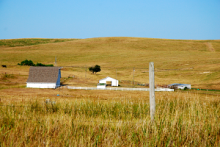Article
A state located at the margin between the Great Plains and what would become the Midwest region of the U.S., Nebraska was part of the territorial home- and rangeland for several indigenous groups, including the Omaha, the Pawnee, and the Sioux. Alternately claimed by the French and the Spanish, by the early eighteenth century, Nebraska was ceded by the French to the Spanish as part of the Louisiana Territory. By the early nineteenth century, the U.S. was pushing its western frontier beyond the Missouri River by establishing military forts in what would become known as the Nebraska Territory. In 1862, with the advent of the Homestead Act, the U.S. forced large numbers of Native Americans from their lands as the Act opened the territory to aggressive Euroamerican settlement with the offer of free land. By the late nineteenth century, because of its central location in the country, and because it was a prime location for both agriculture and cattle raising, Omaha, Nebraska, became the central hub for railroad transportation and shipping, the meatpacking industry, and other working class jobs, inspiring many African Americans, as well as other ethnic minorities, to migrate there in search for work at the turn of the twentieth century.
Today, the capital of Nebraska is Lincoln, which is also the location of the University of Nebraska. The largest city in the state remains Omaha, which holds the College World Series annually. Due to the vast treeless prairies, this state also experiences many tornadoes.
"Nebraska" by Mindy is licensed under CC BY-NC-SA.
Manuscripts
References
Beezley, William H.
1972 Homesteading in Nebraska, 1862-1872. Nebraska History 53: 59-75.
Encyclopædia Britannica Online
N.d. Nebraska. http://www.britannica.com/EBchecked/topic/407533/Nebraska, accessed
December 08, 2014.
Chudacoff, Howard P.
1972 Mobile Americans: Residential and Social Mobility in Omaha, 1880-1920. New York:
Oxford University Press.

